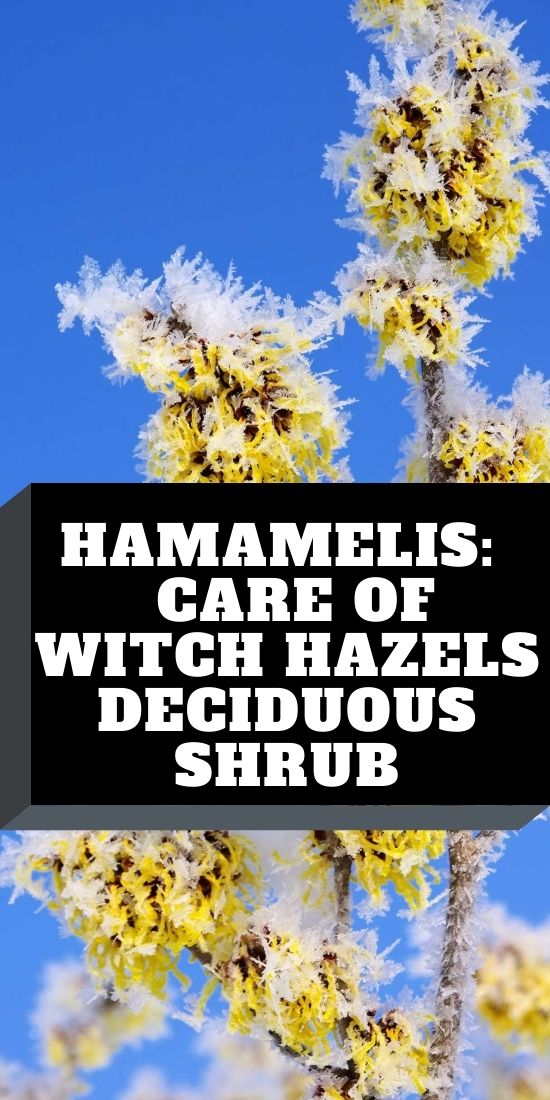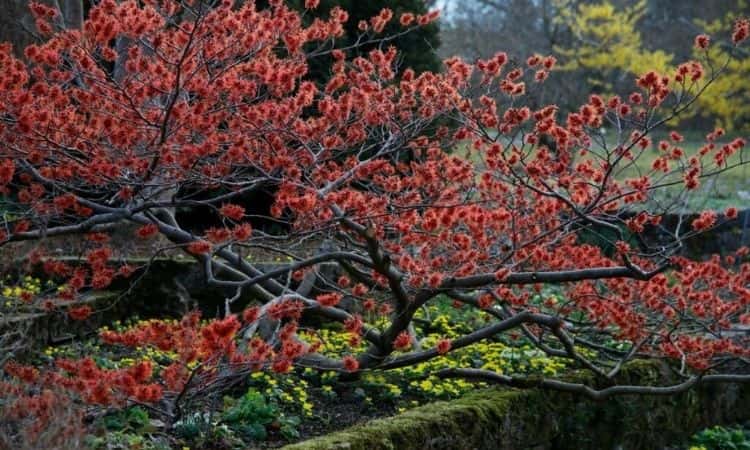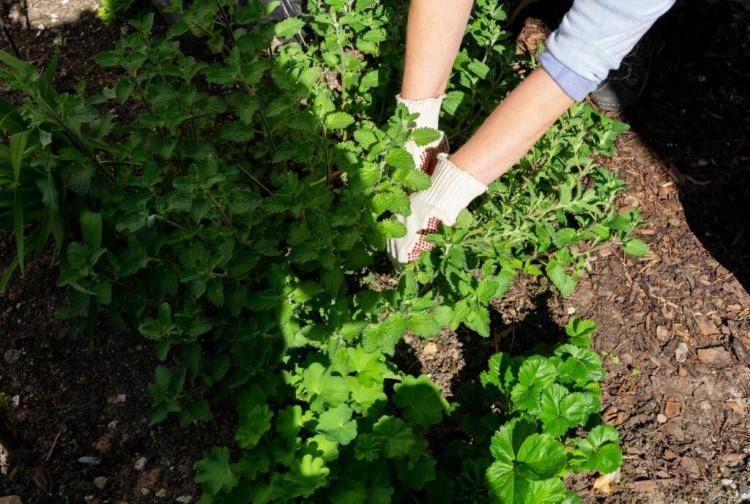Hamamelis: Everything To Grow And Care Of Witch Hazels Deciduous Shrub
The Witch Hazels is one of the particularly timely flowering trees in the garden. Here’s everything you need to know about Hamamelis.
In autumn you can see the colorful foliage of the deciduous shrub already glowing from a distance in yellow, orange, red, and also in winter, the Hamamelis conjures colorful flowers in the garden. Outside the flowering period, the Hamamelis resembles the hazelnut (Corylus avellana). But here the similarities stop. The plant belongs (unlike the hazelnut) to the family of the Hamamelidaceae.
This family can be traced back to the Cretaceous period 100 million years ago and is, therefore, one of the oldest covered plants on earth. Despite this long history, the Hamamelis is still quite rarely found in the garden, but the queen of winter flowers is a real eye-catcher, who does not require much care at the right location and serves bees and bumblebees as one of the first food sources.
Hamamelis: Characteristics, Species, and Varieties
Table of Contents
There are only five different types of Hamamelis in the world, all of which are at home in the temperate areas of the northern hemisphere. Three species come from eastern North America and two species call eastern regions of Asia their home. There were probably also species native to Europe, but they probably became extinct during the last ice age. Among the still existing species, those whose spatial separation is also greatest differ most – especially in terms of flowering phase length and flower size.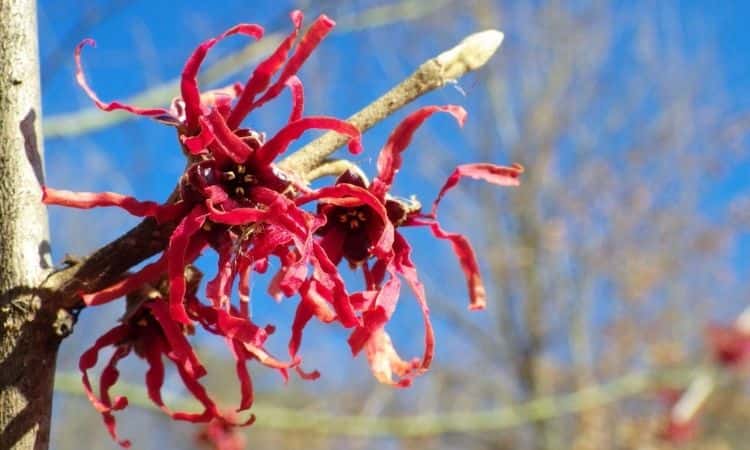
Here is a brief overview of the five Witch Hazels species:
Hamamelis virginiana: This species is an economically used medicinal plant whose active ingredients have an oral, anti-inflammatory, and itching-killing effect. This species shows its delicate yellow flowers as the only species in autumn. As a result, some of the flowers are still covered with foliage.
Hamamelis vernalis: The flowering period is between January and February. The species has short and orange-yellow petals. The leaves are bare except at the middle rib.
Hamamelis ovalis: This is the latest Hamamelisspecies. It was only discovered in 2006. It blooms from December to January in colors from yellow, orange to red, and even in pink.
Hamamelis japonica: The flowering period is between January and February; the flowers show up in a strong yellow. The species is more sensitive to frost than the others and rolls in its petals at low temperatures. Their autumn foliage is bright red.
Hamamelis Mollis: The golden-yellow, delicately fragrant flowers show up from February to March. The petals are up to 1.5″ long.
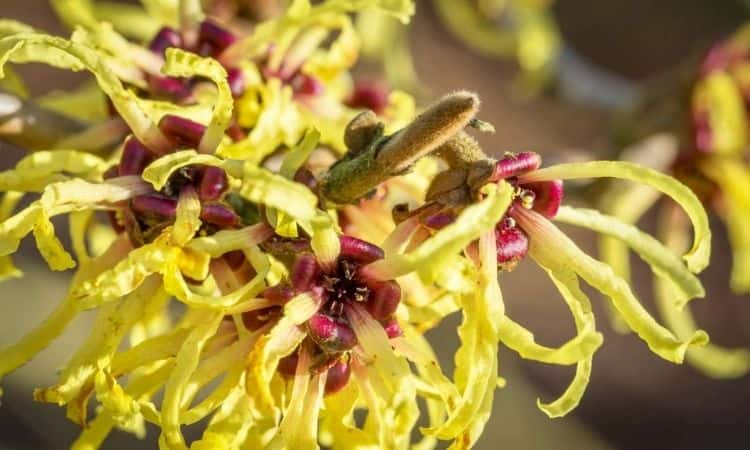
But it’s not just the species that are different. A wide range of varieties allows you to choose between flowers in shades of green, yellow, orange, and red, which smell weak to intense. The same color variance can be found in the intensely colored autumn foliage of the Hamamelis varieties.
Popular Hamamelis species and their varieties
The two Asian varieties are particularly popular as ornamental plants. They have particularly large flowers, which show up from December to March. No wonder that there are now also hybrids (Hamamelis × intermedia) from the two species. The hybrids have the advantage that they have bred away from the alternate of the Chinese Witch Hazels. This means that they bloom equally every year. Normally, flower-rich years are always followed by years with a leaner flowering yield. Due to these advantages, most commercially available varieties belong to the Hamamelis × intermedia.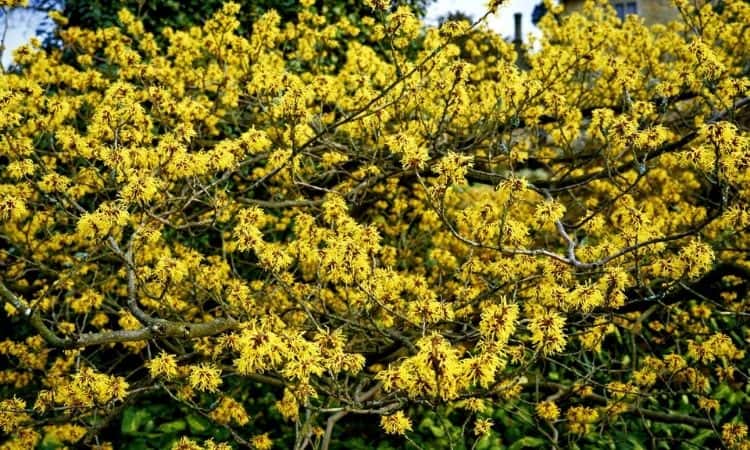
Here are some beautiful and diverse varieties of Hamamelis:
‘Pallida’: Smells of primroses; large yellow flowers; blooms in mild areas already at Christmas.
‘Jelena’: Bright red-orange flowers; scarlet foliage coloring; early flowering with very long petals that become brighter towards the top.
‘Diane’: Intense red flowers that turn brown-red towards the base; Flowering does not begin until February; Autumn leaves orange-yellow to scarlet- small-growing.
‘Primavera’: Medium-sized, golden-yellow flowers; slightly curled petals; blooming early.
‘Arnold Promise’: medium-sized flower; deep light yellow; flowering and growing; expansive, bushy growth; light fragrance; Autumn color yellow; small-growing.
Planting Hamamelis In The Garden
The choice of location should be considered during planting because a Hamamelis takes years to root really well and grow properly. It is particularly important to pay attention to the nature of the soil. Because in the soil, the otherwise so sufficient shrubs are rather demanding: they are sensitive to drought, compaction, and waterlogging. The soil should have the following properties:
- Easy
- Profound
- Permeable
- Slightly moist
- Very humus-rich
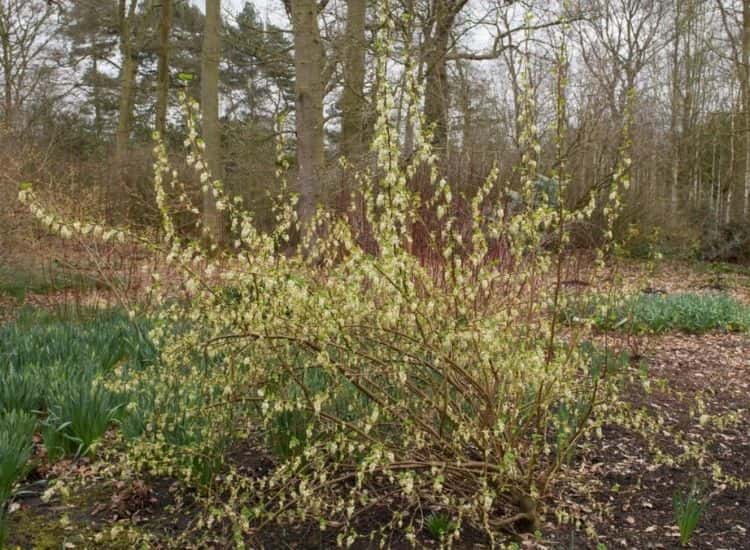
The Perfect Location For The Hamamelis
The Hamamelis prefers a sunny to semi-shady, as protected as a possible location. Although the noble shrub is hardy, the flowering suffers in too harsh weather conditions in winter. The stormy easterly winds also cause problems for the plants. A protected location, on the other hand, ensures a continuous flowering. The slow-growing shrubs take two to three years to get used to their new location and to root well. After that, the plant exudes vigorously and can no longer tolerate transplanting well.
Therefore, consider three times where your Hamamelis should last its existence. Even if the transplant has been well prepared, the next flowering will be sparse. But it is not only the lack of joy in relocations that should be taken into account. The low-competitive plants prefer to stand individually for themselves. They are therefore wonderfully suitable as solitary plants.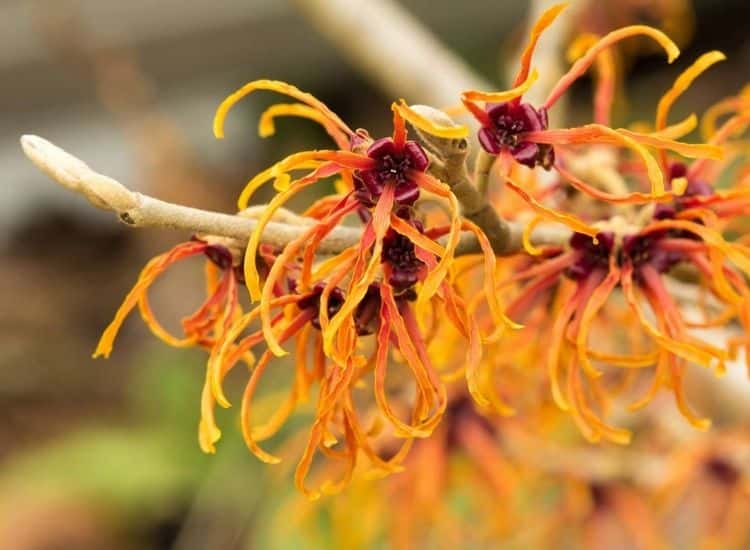
When planting groups, it is important to keep enough distance, because the crowns can be four to 5 yards wide. Groups of varieties with different deciduous colors look particularly beautiful. If you want to socialize your Witch Hazels despite the competitive rootwork, you will find here the right planting partners and further tips for successful crowing the plants.
Planting Time And Procedure
The Hamamelis is planted in autumn before the first frost. If you have purchased container plants, they can also be planted in spring. Dealing with container plants is generally a bit easier than handling bare-root shrubs. However, the following instructions do not cause any problems for the bare-root specimens. The first two points are omitted when planting container goods:
- Put roots in water for about an hour
- Gently loosen the roots and easily separate them from each other
- Loosen the soil well
- Planting hole: About twice the size of the root bale
- Enrich excavated soil with compost and loosen it up well again
- Put the plant straight into the planting hole
- Set the plant only so deep that the pot bale can still be seen superficially
- Filling the planting hole with the prepared soil
- Cover root area with bark mulch
- Do not work the soil after planting
It is recommended to cut the plant back a bit after planting.
Summary: Planting Hamamelis in the garden
- Location: Sun to light shade; protected as much as possible
- Soil: Loose, deep, well-drained, fresh to slightly moist, very rich in humus
- Observe sufficient planting distance and competitive weakness of the root plant
- Planting time: Autumn, also possible in spring for container plants

Properly Prune Hamamelis
Hamamelis don’t have to be cut back at all. They usually form a beautiful and regular crown on their own. With strong pruning, the plants can even die, because the slow-growing plants from old wood only emanate very badly again. Their wound healing also leaves much to be desired. Minimal shape cuts can still be made. The plants also like to lack a branch for the vase. But there is not much more in it.
The Right Time To Cut Of Hamamelis
If you want to cut back, the best time is spring after flowering. After the hibernation stop in winter, the plant has the most energy. This can then be put into wound healing and re-shoot.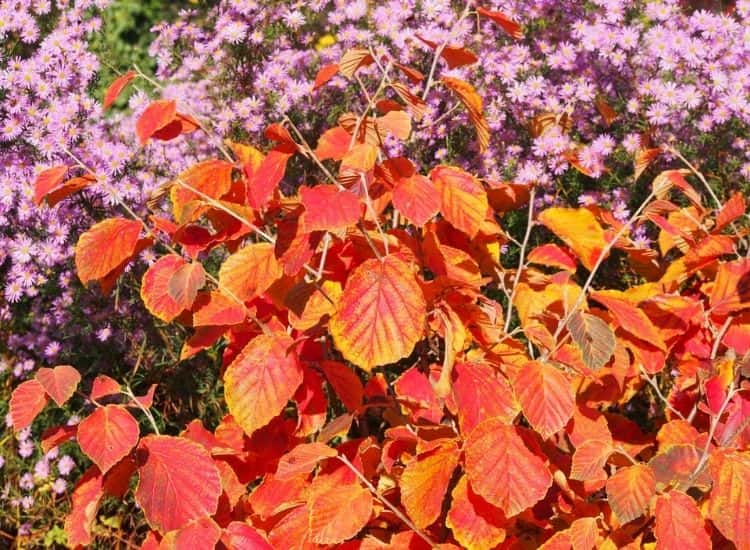
The Procedure For Hamamelis Cutting
With Witch Hazels, you should really rein in the cutback, because the plants don’t necessarily thank you for the pruning. If you have already cut back, please use particularly sharp and clean garden scissors. In this way, the poorly healing wounds are minimized. It is also best to leave the fingers of fully mature, thicker branches and limit yourself to young, thin shoots. For cutting back a Hamamelis, the following applies:
- Pruning as little as possible
- Avoid radical cut
- Only lightened slightly
- Remove dry twigs and branches
Maintaining Hamamelis Properly
If you have considered all the important things during planting, Hamamelis is extremely undemanding winter bloomers. They only need to be cast in case of prolonged drought. Make sure that neither waterlogging forms nor the soil dry out completely. A layer of bark mulch covering the root area protects against drying out. This mulch layer is removed and replaced every year during fertilization.
The annual fertilization takes place in spring and is especially necessary for sandy soil. Just do the following:
- The old mulch layer is removed
- Enrich compost with some horn chips
- Apply a layer of the mixture about 0.7 – 1″ high in the root area
- Apply a new mulch layer in the root area
In late summer or early autumn, you should supply your Hamamelis with a nutrient fertilizer again. This sustainably promotes soil life and thus ensures the good soil quality so badly needed by the Witch Hazels.
In addition, use Kalimagnesia (Patentkali) so that the plant sheds all leaves in time for flowering. So you have an undisturbed view of the flower splendor. This is especially necessary for varieties such as ‘Sunburst’ and ‘Brevipetala’, which sometimes only shed their foliage in spring. If your Hamamelis feels neglected, it will show you this through a meager growth and a lean-to absent bloom. A lack of flowering may be due to the following reasons:
- Dryness
- Pruning
- Frost
Heavy frost can delay flowering for several weeks into February. For the young Hamamelis, the crown can be covered with fleece to protect against heavy frost in winter. This is how you protect the flowers. The shoots are extremely hardy and do not need protection.
Witch hazel is a fairly undemanding garden resident that does not require much care. Further tips for easy-care garden design can be found here.
